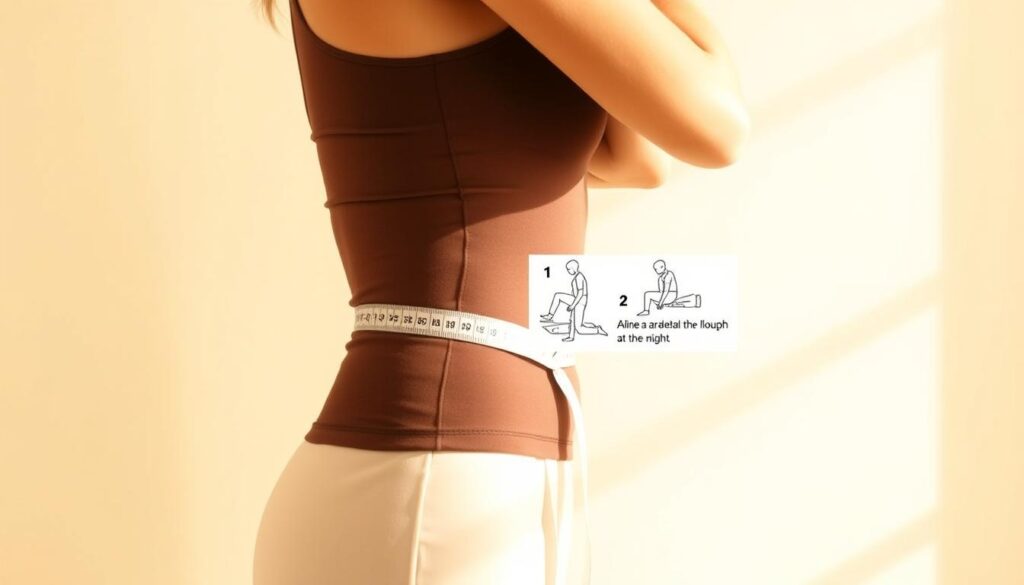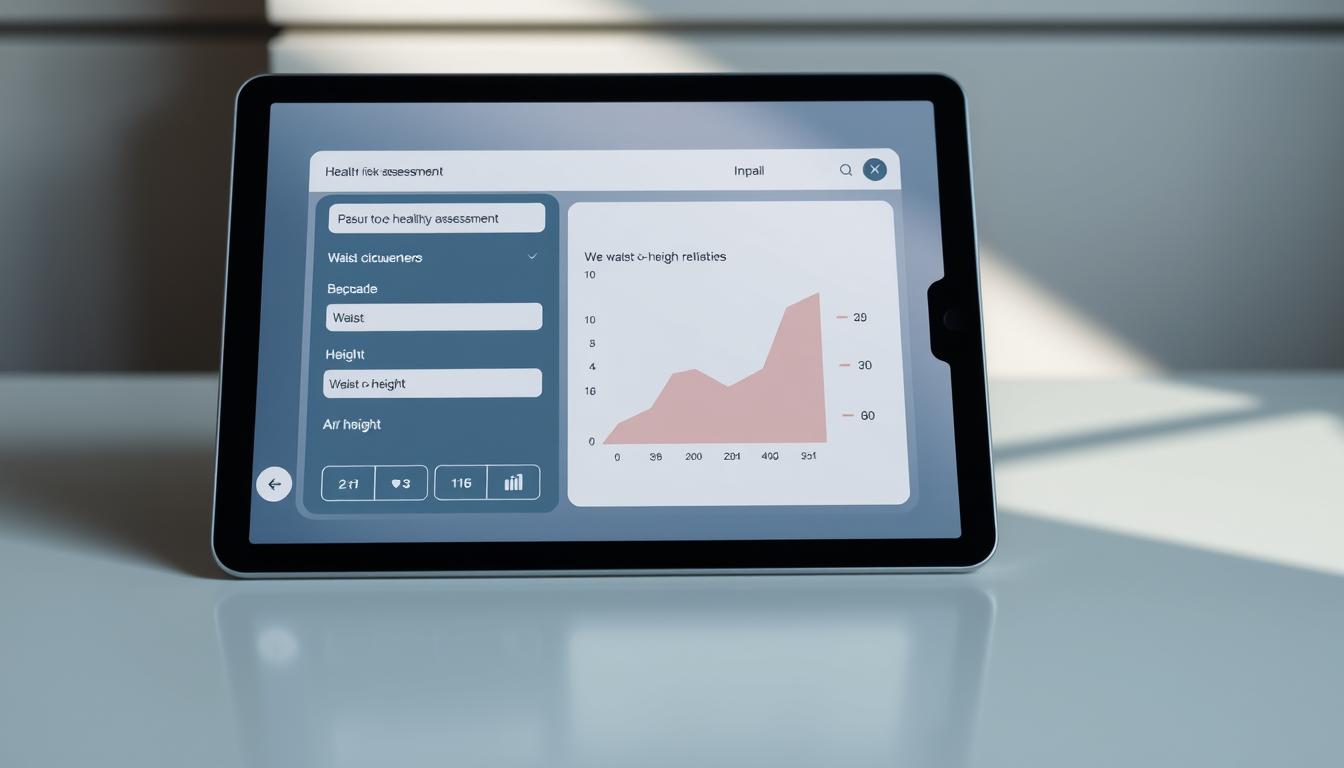What if a single number could reveal your risk for diabetes, heart disease, or other serious health issues? Most people focus on weight or BMI, but abdominal fat distribution might tell a more accurate story about your well-being. Let’s explore how a simple measurement can unlock insights into your long-term health.
Our reliable online tool helps you calculate this critical metric in seconds. Unlike traditional methods, it focuses on where your body stores fat—a key factor in predicting cardiometabolic risks. Studies show that excess belly fat significantly increases the likelihood of developing chronic conditions, even if your overall weight seems normal.
Here’s how it works: measure your midsection and compare it to your stature. The result highlights whether you’re in a healthy range or need to take preventive action. While BMI only considers height and weight, this approach better reflects fat concentration around vital organs.
Key Takeaways
- A waist measurement divided by height predicts health risks better than weight alone
- Abdominal obesity strongly correlates with heart disease and type 2 diabetes
- Our calculator uses globally recognized standards for accuracy
- Healthy results typically fall at or below 0.5
- Regular monitoring helps track progress toward wellness goals
- Always consult healthcare providers for personalized medical advice
In the following sections, we’ll guide you through proper measurement techniques and explain how to interpret your results. You’ll also discover practical strategies for improving your score and reducing health dangers. Remember—this tool complements professional guidance but doesn’t replace it.
Understanding the Importance of Waist-to-Height Ratio
Health experts increasingly recognize that where fat accumulates matters more than total body weight. The World Health Organization notes that visceral fat—the kind surrounding internal organs—triggers inflammation and insulin resistance. This makes proportional measurements critical for predicting long-term wellness.

Why Location Matters More Than Mass
Traditional metrics like body mass index (BMI) often miss hidden dangers. A person with “normal” BMI could still carry hazardous abdominal fat. Studies show those with elevated midsection measurements face double the risk of heart issues compared to individuals with healthier proportions.
The Universal Health Indicator
Guidelines from NICE reveal that maintaining measurements below 0.5 significantly lowers metabolic disease risks. Unlike waist-hip comparisons, this approach works equally well for children and adults. For every inch gained around the midsection relative to stature, cardiovascular strain increases.
Recent research comparing assessment methods found:
- Proportional measurements detect early-stage diabetes risk 30% better than BMI
- Visceral fat reduction improves blood pressure faster than overall weight loss
- Children above 0.5 thresholds develop obesity-related issues earlier
We recommend pairing these insights with professional medical guidance. Tracking changes every three months helps identify trends before they become critical.
How to Accurately Measure Your Waist and Height
Getting precise numbers starts with proper technique. Let’s walk through the process endorsed by global health authorities.

Proper Techniques and Tape Measure Tips
Use a non-stretch tape to find your natural waistline—the soft area above your hip bone but below the ribcage. Stand relaxed with feet shoulder-width apart. Breathe normally, and wrap the tape snugly without pressing into skin. Record the number after exhaling gently.
For stature, remove shoes and stand against a flat wall. Position a book horizontally on your head, marking where it meets the wall. Measure from floor to mark using a rigid ruler. Repeat both measurements twice for consistency.
WHO and NICE Measurement Guidelines
Global standards recommend locating the midpoint between your lowest rib and iliac crest for waist checks. “Reliable data requires standardized protocols,” notes WHO research. Avoid these common errors:
- Measuring over thick clothing
- Holding breath during the process
- Slouching during height assessment
NICE emphasizes using validated tools and recording to the nearest 0.1 cm. Following these steps helps spot true health trends rather than measurement quirks.
Using Our Waist-to-height ratio calculator for Personalized Health Insights
Discovering your body’s unique health profile takes just two measurements and a few clicks. Our free calculator transforms your midsection and stature data into actionable insights using clinically validated methods.
Three Simple Steps to Your Results
- Wrap a flexible tape measure around your natural waistline (above hips, below ribs)
- Stand straight against a wall to measure your full stature without shoes
- Enter both numbers using matching units – inches or centimeters
The tool instantly compares your proportions against global health benchmarks. We categorize results into four clear ranges based on peer-reviewed studies:
- Optimal: Below 0.5 – Maintain current habits
- Elevated: 0.5-0.6 – Consider lifestyle adjustments
- High Risk: Above 0.6 – Seek professional guidance
Your data never leaves the browser – we prioritize privacy while delivering instant analysis. For families, the tool adapts to children’s growth charts when age data accompanies measurements.
Regular checks help track changes in fat distribution around vital organs. Pair these insights with our nutrition and exercise guides for complete wellness management. Remember: this assessment complements – but doesn’t replace – medical consultations.
Interpreting Your Waist-to-Height Ratio Results
Your health numbers tell a story—learn how to read yours. The waist-height ratio calculator translates measurements into clear risk categories using global health standards. Let’s decode what these values mean for your well-being.
Healthy Ranges and What They Mean for You
Research shows ratios below 0.5 signal low health risks. This means your midsection measures less than half your stature. Values between 0.5-0.6 suggest moderate risk, while scores above 0.6 require immediate attention.
| Category | Ratio Range | Health Implications | Action Steps |
|---|---|---|---|
| Optimal | 0.4-0.5 | Low heart disease risk | Maintain habits |
| Elevated | 0.51-0.59 | 15% higher diabetes risk | Improve nutrition |
| High Risk | 0.6+ | 2x vascular issues | Consult doctor |
Understanding Risk Categories in Detail
A 0.52 ratio increases metabolic strain compared to 0.48. Why? Fat around organs (visceral fat) disrupts hormone balance. Even small changes matter—reducing your ratio by 0.03 cuts heart disease risk by 12%.
Body fat distribution refines your risk profile. Two people with identical ratios might face different dangers based on where fat accumulates. Pair your results with professional advice for tailored strategies.
Remember: These numbers guide—not define—your health journey. Regular checks help track progress, while medical experts provide personalized solutions.
Practical Tips for Improving Your Health Metrics
Small daily choices create lasting changes in how your body stores energy. Research proves that combining smart nutrition with consistent movement helps reshape your midsection while boosting overall wellness.
Fueling Your Body Wisely
Start with whole foods that fight stubborn fat. The CDC recommends filling half your plate with colorful vegetables and fruits. Swap processed snacks for nuts or Greek yogurt—studies show these choices reduce waist measurements by 3% in 12 weeks.
Portion control matters more than drastic diets. Use your hand as a guide:
- Palm-sized protein portions
- Fist-sized complex carbs
- Thumb-sized healthy fats
Avoid liquid calories from sugary drinks. “Water-rich foods and herbal teas naturally curb hunger,” notes a Harvard Medical School report. Track progress monthly using our measurement tool to spot trends.
Moving Toward Better Numbers
Blend aerobic exercise with resistance training for maximum impact. The American Heart Association suggests:
- 150 minutes weekly of brisk walking or cycling
- Two strength sessions targeting major muscle groups
- Daily stretching to improve posture and circulation
Consistency beats intensity. A 2023 Johns Hopkins study found participants who exercised 20 minutes daily improved their proportions faster than weekend warriors. Pair activity with 7-9 hours of sleep—poor rest increases fat storage hormones.
| Change | Benefit | Timeframe |
|---|---|---|
| Swap soda for water | Reduces belly fat | 8 weeks |
| Add daily walks | Improves circulation | 2 weeks |
| Strength train 2x/week | Boosts metabolism | 4 weeks |
Remember: Sustainable changes yield measurable results. Our assessment tool helps track improvements while celebrating milestones. For families, involve children in meal planning and active play to establish lifelong healthy habits.
Conclusion
Taking charge of your health begins with understanding your body’s signals. Our exploration confirms that tracking midsection proportions offers clearer insights than weight alone. Maintaining measurements below the 0.5 research-backed threshold helps reduce risks for chronic conditions linked to abdominal fat.
Remember: keeping your waist size under half your stature creates a strong defense against metabolic issues. Follow our guide on proper measurement techniques for accurate tracking. Pair this with regular checks using our digital tool to spot trends early.
We designed this resource to empower your wellness journey. Share your results with healthcare providers to create personalized strategies. Explore our nutrition guides and exercise plans to support lasting changes.
Every measurement matters. Start today—your future self will thank you.


